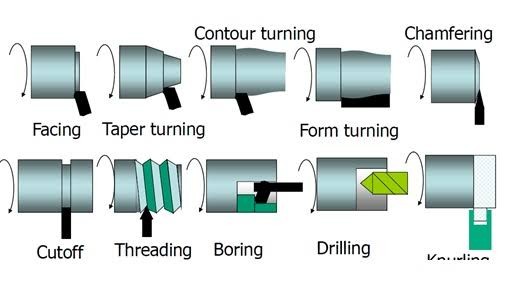The 10 lathe machine processes that every manufacturer should know include cutting operations, drilling operations, boring operations, grinding operations, threading operations, reaming operations, facing operations, tapping operations, and hobbing operation.
A lathe machine is a common manufacturing tool that is used to create precise, symmetrical parts. The lathe machine processes that every manufacturer should know are turning, drilling, reaming, facing, and tapping. These processes are performed by rotating the workpiece on a lathe and using various cutting tools to remove material.
Lathes are versatile machines that can be used to create a wide variety of parts. In order to get the most out of a lathe, it is important to understand the different lathe machine processes and how they can be used. This blog post will cover 10 lathe machine processes that every manufacturer should know.
Cutting Operations
Lathe machines are used to create rotational parts by cutting away excess material. The cutting operations performed on a lathe machine include turning, facing, taper turning, and threading. These operations can be performed on both ferrous and non-ferrous metals.
Drilling Operations
There are many different types of lathe machines, and each one is designed for a specific process. Drilling operations are one of the most common processes that lathe machines are used for. In this process, a drill bit is used to create a hole in the workpiece. The depth of the hole and the diameter of the drill bit will determine the size of the hole that is created.
Boring Operations
Boring operations refer to the process of enlarging or achieving a more precise diameter of a hole that has already been drilled. This is done by using a rotating cutting tool that removes material from the workpiece. Boring can be performed on both ferrous and non-ferrous metals.
Grinding Operations
Grinding is usually performed after machining operations are complete. The grinding process removes any remaining material on the workpiece, as well as any burrs or sharp edges. This leaves the workpiece with a smooth, polished finish.
Threading Operations
There are various threading processes that can be performed on a lathe machine, and each has its own advantages and disadvantages. The most common threading processes are turning, boring, and drilling.
Reaming Operations
Reaming is a finishing operation performed on a lathe machine. Reaming produces a smooth, precise hole with a smooth surface finish. The reamer is a cutting tool that has multiple cutting edges that remove small amounts of material as it rotates. Reaming is typically done to enlarge an existing hole or to finish the edge of a hole.
Facing Operations
Although operations such as drilling and reaming are performed on the face of the workpiece on a lathe, these are not considered "facing" operations. Facing is reserved for operations that produce a flat surface perpendicular to the axis of rotation of the workpiece. Common facing operations include turning, boring, and planing.
Tapping Operations
Tapping is a process used to cut or form internal threads in a workpiece. A tap is inserted into the workpiece and rotated to cut the thread. Tapping can be performed manually or using a machine. Machine tapping is faster and more accurate than manual tapping.
Hobbing Operation
A hobbing operation is a process used to cut gears. It is performed on a lathe machine. The cutter, or "hob," is a tool with multiple teeth that are shaped like the teeth of a gear. The hob is mounted on the spindle of the lathe and rotated at high speed. The workpiece, which is also mounted on the spindle, is fed into the cutter. The cutter cuts the teeth into the workpiece as it rotates.
In conclusion, there are 10 lathe machine processes that every manufacturer should know. By becoming familiar with these processes, manufacturers will be able to produce more consistent and higher quality products.

Comments (0)
Please login to join the discussion
Be the first to comment on this article!
Share your thoughts and start the discussion